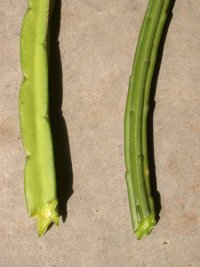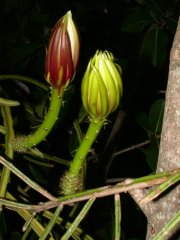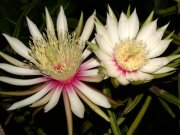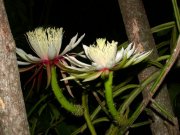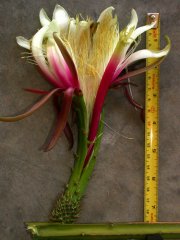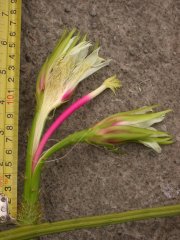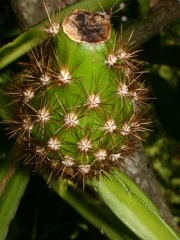 |
QUICK SEARCH
MO PROJECTS:
Africa
Asia/Pacific
Mesoamerica
North America
South America
General Taxonomy
Photo Essays
Training in Latin
America
MO RESEARCH:
Wm. L. Brown Center
Bryology
GIS
Graduate Studies
Research Experiences
for Undergraduates
Imaging Lab
Library
MBG Press
Publications
Climate Change
Catalog Fossil Plants
MO DATABASES:
W³MOST
Image Index
Rare Books
Angiosperm
Phylogeny
Res Botanica
All Databases
INFORMATION:
What's New?
People at MO
Visitor's Guide
Herbarium
Jobs & Fellowships
Symposium
Research Links
Site Map
Search
|
Draft Treatments | Guidelines | Checklist | Citing | Editors The Cutting EdgeVolume XIV, Number 3, July 2007News and Notes | Leaps and Bounds | Germane Literature | Season's Pick | Annotate your copy SEASON'S PICK: Selenicereus inermis (Otto) Britton & Rose vs. S. wercklei (F. A. C. Weber) Britton & Rose (Cactaceae): a taxonomic and photographic showdown! Ever since INBio's survey of the area upriver from the long-planned-to-be-dammed Río Grande de Térraba gorge [see The Cutting Edge 7(2): 1, Apr. 2000], we have been nurturing a cutting from the spineless, scandent, and epiphytic cactus that we reported at that time as being a new in-country disjunct of the endemic Selenicereus wercklei. From the outset, we were suspicious that this south(eastern) entity might prove to be something different; its stems are slightly thicker (ca. 2 cm) and with fewer [3–5(6)] and more prominent ribs than the typical, northern populations of S. wercklei (with ca. 1 cm, 6–9+-ribbed stems):
In the Selenicereus key of Britton and Rose (The Cactaceae. Vol. 2. 1920), two spineless spp. were recognized:
Could the plant from the Térraba region be S. inermis? Certainly its rib features suggested this, but we still had not seen flowers. Finally our plant—having nearly perished but eventually surviving and now thriving—flowered this past season (seven years flew fast!), and our suspicions that its flowers might differ from those of the more northern populations were confirmed. But immediately we noticed something awry, with respect to the Britton and Rose key: if anything, the flower color was reversed, the outer tepals of the plant with few-ribbed stems being red, vs. green in the plant with more abundantly, but less prominently ribbed stems! In the following series of photos, the flower on the left is from the Térraba plant, the one on the right from a plant cultivated at a house in Tibás (Valle Central), very near INBio. The Tibás plant, which flowers every year during this season, is of undetermined wild origin, but is typical of wild plants known from the Cordillera de Guanacaste, and elsewhere north of San José. The first three photos were obtained by placing a piece of the Tibas plant, with a mature flower bud, beside a mature bud on the Térraba plant growing at our house in Santo Domingo, and watching the two open in the evening.
In summary, we list here the most noticeable differences between the flowers of these two plants:
The motivation for the title of our story is that Selenicereus wercklei was recently placed in synonymy of S. inermis (see Bauer, Cactaceae Syst. Init. 17: 1–63. 2003). While Dr. Bauer's arguments are cogent and his taxonomy is the logical one to follow, his statement that "The flowers of all these [Costa Rican plants with various stem morphology] are the same as in typical S. inermis and therefore I consider S. wercklei to be a synonym of S. inermis" (p. 48, loc. cit.) suggests that Selenicereus flowers in Costa Rica are all the same*. Based on our close look at flowers of two of these plants, such is obviously not the case (though Bauer has seen specimens of other fertile material with 4–6 ribs that we have not). If these floral differences were found to be consistenly associated with the two different stem forms, taxonomic recognition, at least at the subspecific level, would seem to be in order. One final note: the photo below is of the single, still-maturing fruit on our Térraba plant, produced by dusting stigmas (of several of its flowers) with pollen from the Tibás plant! N.B.: both of these plants appear to be self-sterile. * Selenicereus testudo (Karw. ex Zucc.) Buxb., the only other Selenicereus that has been known from Costa Rica, is now placed in Strophocactus, and thought not to belong even to the tribe Hylocereeae.
Photos by B. Hammel. Térraba plant vouchered by Hammel & Pérez 24274 (CR, INB, MO), Tibás plant by Hammel & Pérez 24275 (CR, INB, MO), Guanacaste plant by Hammel 17810A (CR).
|
||||||||||
© 1995-2025 Missouri Botanical Garden, All Rights Reserved
4344 Shaw Blvd.
St. Louis, MO 63110
(314) 577-5100
Technical Support
